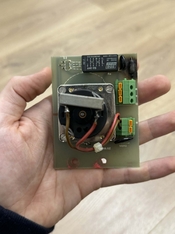All options have their pros & cons. Ultimately I settled for a boring old 20x4 alphanumerical character display on my present controller. The reason is mostly because I could hack/modify these pretty easily to install a red, amber and a white backlight (the latter was already there; I just added the red & amber). Since I do both color and B&W, I wanted red for B&W work and amber (very dim!) for color.
E-ink is certainly possible, but as you said, the refresh rate is somewhat limited, which is the main reason I also skipped that option. You can do refresh rates of maybe 4Hz or so on e-ink, which doesn't allow for very smooth cycling through numerical values (you need about 10Hz or so to have a smooth user experience).
Initially I used 7-segment displays, which is fine if you're OK with having a single color. If you only do B&W work, then just use a red 7-segment display and call it good. You can put some additional rubylith on top to filter out the smaller wavelengths. It'll work just fine that way. If you also want to do color, you could use amber, which will also work reasonably well for B&W work as long as you keep the light level down. Some papers won't mind (Ilford) while some will fog to amber 7-segment displays (Foma). Note that you can NOT filter an amber 7-segment display to red etc. These are essentially LEDs, so fairly narrow wavelengths. If you put a red filter over an amber LED, you see virtually nothing.
I've seen projects where reasonably fancy red backlight dot matrix displays were used; you could e.g. use something like a Nokia 5110 display (these are quite popular in DIY circles) with a red backlight if you can find/hack one. There are bigger/nicer graphic displays with red backlight as well, but in the DIY community they're few and far between. I think for you it would be ideal if you could just use a ready-made module that you can interface with through SPI or I2C and for which a solid Arduino library is available.
I'd steer clear of IPS displays; they're nice in principle, but the backlight will be a (big) problem. OLED may work if you can find actual RGB displays (most DIY OLEDs are white, blue and/or yellow) and then use only the red channel for your enlarger. This may or may not work well for B&W printing (it'll be useless for color work unless you're OK with the display being off during exposures); the main issue will be the wavelength of the red, which is likely around 620nm (and it'll usually not be specified to begin with, or you have to look very hard to find it). For a B&W safelight it's nicer to steer towards 650-660nm LED. If you hack a cheap 16x2 or 20x4 or so, you can pretty much pick any color LED you want. Plus, they're cheap, easy to control from Arduino projects and it's relatively easy to replace the backlight LED with something of your choice.



 My friend and I are getting close.
My friend and I are getting close. 
